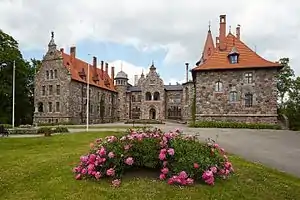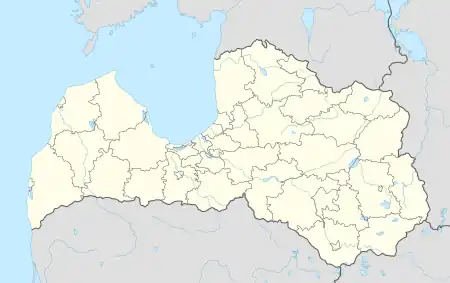Cesvaine Palace
Cesvaine Palace (Latvian: Cesvaines pils; German: Schloss Seßwegen[1]) is located in the town of Cesvaine, Latvia in Madona Municipality. Next to the palace lies remains of the old bishop's castle.
| Cesvaine Palace | |
|---|---|
 | |
 | |
| General information | |
| Town or city | Cesvaine |
| Country | Latvia |
| Coordinates | 56°51′30″N 26°13′41″E |
| Completed | 1896 |
| Client | Adolf Gerhard von Wulf |
| Design and construction | |
| Architect(s) | Hans Grisebach August Dinklage |
History
Cesvaine Palace was built in 1896 for the German baron Adolf Gerhard von Wulf (not to be confused with the von Wolf baronial family).[2] Authors of the project were architects Hans Grisebach and August Dinklage from Berlin.[3] The palace is built in the late Tudor Neo-Renaissance style.
At the end of the 19th century, Germany abandoned the reproduction of old German prototypes and turned to England in search of inspiration, namely to late Tudor-style architecture. The style had preserved certain Gothic elements. Picturesque frames, towers and turrets of different forms and sizes, high decorative chimneys and steep roofs were all characteristic features of the style.

Cesvaine Palace is an impressive construction representing this trend in Latvia. Abandoning forms of the German Renaissance, Griesebach created an unusual, noble and welcoming construction. It is a romantic and picturesque building, and its architecture harmonizes with the landscape. The palace is built of stone, skilfully using the colour and texture of the material. The architect has applied the principle of contrast- the facade is enriched by balconies and impressive pediments. The round tower with a helmet appears to be a successful addition. The building is renowned not only for its size and frame, but also for the quality of construction. The facades are in medieval style, creating the impression of medieval fortification.
In 2002, due to numerous fire safety regulation violations[4] a fire broke out and destroyed the palace's roof, parts of second floor and the representative spaces in the first floor. In 2003, restoration work commenced and was finished in 2022 when the palace was once again reopened to visitors.[5]
References
- Rene Levoll: "The last motor race of the empire (ee: Impeeriumi viimane motovõistlus, de: Das letzte Autorennen des Imperiums)", Tallinn 2014, Estonian Old Technics Museum Foundation, page 81 "list of former and present place names of places"
- Richard C. Frucht (31 December 2004). Eastern Europe: An Introduction to the People, Lands, and Culture. ABC-CLIO. pp. 143–. ISBN 978-1-57607-800-6. Retrieved 15 August 2012.
- "Cesvaines Palace". Latvijas Tūrisma objektu datu bāze. Archived from the original on 19 February 2013. Retrieved 28 August 2012.
- "Violations of fire-prevention norms could be reason for fire in Cesvaine Castle". building.lv. Retrieved 15 August 2012.
- Zvejnieks, Lauris (8 February 2022). "Cesvaine castle to open doors after 20 years of reconstruction". Public Broadcasting of Latvia. Retrieved 8 February 2022.
.svg.png.webp)